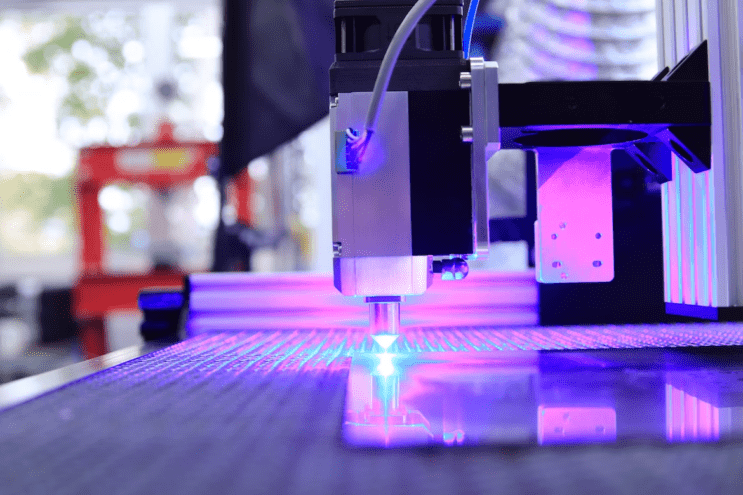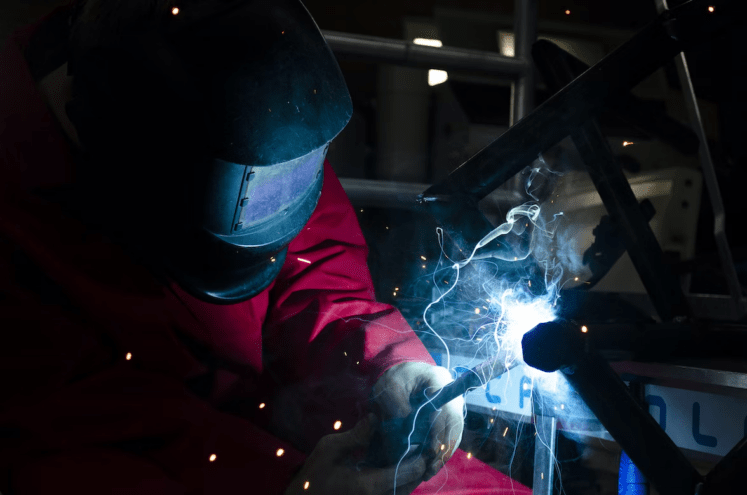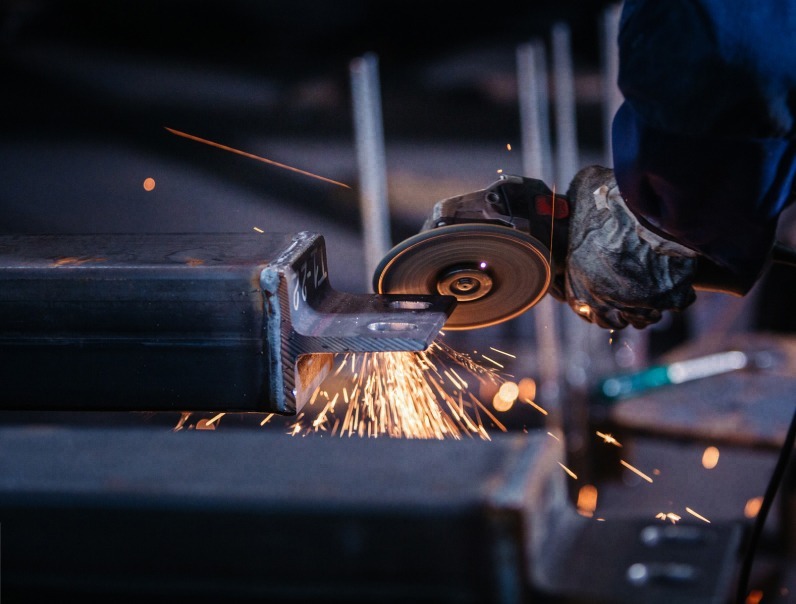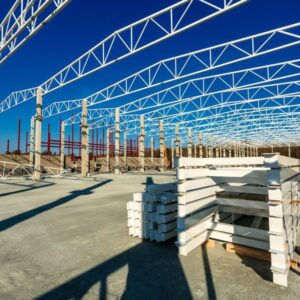The amount of appliances in our daily lives that come from metal fabrication is massive, including tools, electronic appliances, cars, phones, and so on. Metal fabrication is a massively complicated process that has many different variations, each of those suitable for a specific goal.
We would go to each and every one of them, but first, we have to explain the basics of metal fabrication as a whole – as well as a few words about different metals used in fabrication.
Hard and soft metals
Metals themselves can be separated into two large categories – hard metals and soft metals. Each category has a share of advantages and a number of issues.
Hard metals
Hard metals are stainless steel, chrome, steel, Inconel, and titanium. Each of these can be created during the smelting process by adding a small percentage of other elements to the alloy. Adding molybdenum and chromium creates 4140 steel alloy, which is great for aircraft creation and similar use cases, while carbon and manganese create tough 1018 steel. Both of these metal types are easy to weld but are susceptible to rusting if there is no additional finishing on the metal piece.

A combination of nickel and chromium creates 300-series stainless steel which is rather tough when it comes to machining but also makes a great resource for food equipment, medical instruments, pressure vessels, and so on. It also cannot be hardened the way carbon steel does. Another metal variation is 17-4 PH, which is a rather tough material that adds copper, chromium, and nickel to the alloy, creating a material that is technically stainless steel but has the machineability of a superalloy, capable of achieving great results in both tensile strength and hardness when treated with heat. It is a good choice for nuclear and aerospace industries, as well as any other industry that requires high corrosion resistance and incredibly high material strength.
There are also materials suitable for only the most extreme circumstances, such as Inconel – a material that uses over 50% of nickel in its alloy, often used for jet engine combustion chambers, gas turbine blades, and nuclear reactors due to its excellent capabilities with a high range of operable temperatures. Another similar alloy is cobalt chrome – the one that uses cobalt in the alloy, creating a material with massive wear resistance and also, surprisingly enough, biocompatibility with humans. This last reason is why cobalt chrome is often used for knee/hip replacements, dental implants, arterial stents, etc.
The last, but not the least material on this list is titanium, which is twice as strong as mild steel while being half of its weight. It is created via aluminum and vanadium, generating a corrosion-resistant and strung material that is also biocompatible – making it suitable for bone screws, plates, pins, etc. This strength-to-weight ratio is one of the reasons why titanium is so appealing to high-performance vehicle manufacturers and the aerospace industry, as a whole.
Soft metals
A second large category of metals is dubbed “soft metals”, and for a reason. Most of these materials are far from being as strong as basic stainless steel – which also doesn’t make it less useful for specific circumstances. Some of the more common examples of soft metals are brass, aluminum, copper, and magnesium.
Aluminum as an element is extremely malleable and soft, which is why it is basically unusable for mechanical purposes. Luckily enough, it can be used to create an alloy when combined with zinc, copper, magnesium, or silicon (and then made stronger via heat treatment). This kind of material has its use cases in a wide variety of industries, from consumer products to airframes and automobiles.
6061 aluminum is combined with silicon and magnesium to create a corrosion-resistant material that is easy to weld, which is why it is used fairly frequently in all kinds of low-fatigue applications – automotive parts, hydraulic valve bodies, machinery, as well as automotive and marine parts. 7075 aluminum, on the other hand, is stronger and harder than 6061 aluminum, but also several times more expensive. It is created with copper, zinc, and magnesium, with use cases such as wig spars for Boeing aircraft, connecting rods in top fuel dragsters, and even details for a lot of American firearms.
Magnesium is one of the lightest examples of structural metals, which is why it is commonly found in chassis for laptops and smartphones, as well as in frames for power tools, seat frames and transmission cases for automobiles, etc. One of the more common alloys of magnesium is its combination with zinc and aluminum, creating a machineable metal that has excellent dampening capabilities and is easy to mold. It is fairly easy to manufacture, but somewhat more expensive than most of the aluminum variations.
Brass is one of the most versatile materials on this list, boasting extremely high resistance to both corrosion and weather effects. C260 cartridge brass is a good example here, a combination of zinc and copper that is the most “general-purpose” material for all brass-related alloys. It has a tensile strength of mild steel and can be turned into screws, rivets, and many other elements with a relatively simple modification to the original alloy.
Copper, on the other hand, is strikingly different from everything above, even though its biggest component is brass in the first place. It is one of the most electrically-conductive materials in history, one of the few materials that make all of the electricity in the world possible in the first place. It is difficult to weld, but easy to braze – an uncommon combination for metals in general. However, it’s not just about conducting electricity, either – copper is also used in glass-to-metal seals, in semiconductor manufacturing, and even in some specific locations as an antimicrobial surface.
Copper is an ingredient of several hundred different metal alloys, creating nickel-copper, tellurium copper, aluminum, gunmetal, bronze, steel alloys, and so much more.
The definition of metal fabrication and types of fabricated products
As a process, metal fabrication is all about creating various metal structures using different processes using both manual labor and automation. Facilities that specialize in one specific field of metal fabrication are often called fabrication shops, and the products of said facilities are also often called fabrication. It is also true that some other types of metalworking, such as forging, casting, and metal stamping, are not considered fabrication, even though they can be similar in shape.
The most common types of raw materials for metal fabrication are sectional metal, welding wire, plate metal, castings, flat metal, fittings, and more. At the same time, it’s not uncommon for fabrication shops to employ multiple different experts in various fields, like blacksmiths, welders, boilermakers, and ironworkers, among many others.
That’s not to say that the only people employed in fabrication shops are directly related to the process of metal fabrication – there are also managers, team assemblers, solderers, first-line supervisors, brazers, cutters, welders, etc.
As for the types of products that can be created with metal fabrication – it is possible to separate all of them into three segregated categories. Each category has its own variety of processes used in the process of metal fabrication, or it can be just a single process altogether. Here are three main categories of metal fabrication:
- Structural. Mostly covers metal fabrication as a part of the building process, providing metal components to be used in various large-scale fabrication efforts, such as buildings, shops, skyscrapers, and so on.
- Commercial. As the name suggests, this mostly covers the commercial products, designed to be used by customers directly, be it appliances, cars, or something else entirely.
- Industrial. Specializes in creating products that are used as a part of other pieces of equipment – equipment that is used to generate consumer goods, for the most part. Some of the examples of industrial fabrication are ironworking machines and bandsaws, as well as many other ones.
Types of metal fabrication processes
Metal fabrication consists of many different processes that may or may not be involved in the project depending on what needs to be done, as well as the material type and some other dependencies. You can find many different metal fabrication process types in the list below:
- Сutting
- Bonding
- Tooling
- Folding
- Extrusion
- Punching
- Stamping
- Casting
- Drawing
- Forging
- Machining
- Shearing
- Welding.
Now that we’re aware of what they’re called, it’s time to go over what each of those actually implies, starting with cutting.
Cutting
While metal fabrication includes a lot of different processes, cutting is pretty much the most common one out there. The oldest example of a cutting process that can be replicated nowadays is sawing – but there are also many newer ones, using waterjets, lasers, and even plasma arcs to cut metal. The cutting methods can be drastically different, as well, including manual, power tools, computer-controlled cutting, and more.

There are also some cutting types that are extremely specific in the way the cut is performed. For example, there’s cutting with a die as the part that cuts off the necessary part of the material. This includes three general types of die cutting – the regular one, the rotary die cutting, and the flatbed die cutting.
While the regular die cutting process has been explained already – it’s using a die to cut metal, simple as that – two of the other examples are not as obvious.
For example, a rotary die employs a specific cylindrical die that spins around in one place to cut some specific parts of a material. There’s also a flatbed die – reserved specifically for tougher and thicker materials, this one uses a lot more force and flat surface than the other ones.
Of course, these are not the only options to cut metal, since laser cutting also exists – and it is often treated as the preferred way to cut metal. It is quick, precise and does not lead to the metal in question deforming in some way. However, it is at its best when working with sheet metal, and may struggle with thicker metal types – which is where plasma cutting comes in, being a quick alternative to laser cutting that is a bit cruder in how it leaves the cut metal pieces. However, it is sometimes the only option for some of the specific thick metal variations.
Bonding
Bonding is a process of creating a single metal piece from two different ones, it uses the hot and cold cure adhesive method to join these two parts together. An adhesive is placed between two pieces and then either heat or pressure is applied to the location of the bonding, creating a connection between two details.
Tooling
Tooling is a process of creating or acquiring various tools that are necessary for manufacturing to proceed as intended. While this metal manufacturing type is not included in the metal fabrication process per se, it is still an important part of any of the metal manufacturing efforts. Tooling is used to create appliances such as jigs, gauges, dies, fixtures, shapes, cutting equipment, and more.
Folding
Folding is another process that is extremely simple in its concept – all you do is manipulate the raw material to bend it in the desired way. There are three main methods of folding in metal fabrication, and the most common one is with the help of a brake press.
The piece of raw metal is held between a punch and a die, and a punch is used to generate pressure onto the raw material to help it reach the desired shape. This kind of process is quite common for sheet metal shaping.
Additionally, there’s also a manual process of folding a material piece – which includes hammering it until the desired shape is reached – as well as with the help of a specific machine called a folder. The machine itself is quite basic, it has a flat surface with a clamping bar that holds a piece of raw material (sheet metal) in place, and also a front panel that forces the extended part of sheet metal to bend by lifting said front panel upwards.
Extrusion
Extrusion, on the other hand, is a somewhat more complicated process that focuses on making cylindrical items, mostly used either for piping or wiring purposes. This process uses a specifically crafted open or closed die to reduce the diameter of a raw material piece to match the size of the cross-section of the die and to form a cavity inside of a material piece by pressing around a die.
The most common shape of raw material for this operation is the form of a cylinder or a metal slug. There are also two variations of said operation: hot extrusion and cold extrusion.
Hot extrusion is using an increased temperature of the material to make it more likely to be molded in a specific shape and is mostly used for working with materials like copper or aluminum. Cold extrusion, on the other hand, is performed at room temperature and is often used for steel metal fabrication to make the product more durable.
Punching
Punching is a relatively simple process that uses specific machinery to create multiple holes in a piece of raw material. When the end product is the material piece with holes – it is used for fastening purposes. If the end product is a number of metal pieces that were forced out of the original piece of raw material, then this entire process can be qualified as blanking.
Stamping
Stamping is somewhat close to punching, with the main difference being that stamping does not create a hole in the raw material piece, but creates a dent in a said piece. This is commonly used to generate various symbols on the surface of a material piece, be it letters, numbers, or images.
There are two main types of stamping presses out there right now – mechanical and hydraulic. In the majority of cases, stamping is performed on metal sheets with ¼ inch thickness or lower, and it creates an impressive range of products, including coins (a process called coining), smaller metal parts for electronics (four slide forming), and so on.
Casting
Casting is a process of pouring molten metal either poured into a die or a mold and then allowed to cool off to take the desired shape as a finished product. It’s pretty much a perfect process for making identical products using the same mold, particularly useful in mass-production.
Of course, there are different variations of casting, as well. For example, die casting uses a die as a holding place for a molten metal instead of a mold, and the shape of the final product is decided upon by the form of a die and by the amount of pressure applied to it.
There’s also a permanent mold casting, as in using a mold as the “storage” for the molten metal. The end product is stronger than with other types of casting, but it also makes it way harder to remove the mold after the product is done cooling and taking shape.
A different type of casting can theoretically fix the problem of removing the mold, called semi-permanent mold. It uses an expendable core in the mold to make the removal process far more simple than with permanent molds.
We’re finishing off with sand casting, in which your mold is represented by a pattern in the sand. This particular process is slower than the other ones, but it’s also somewhat more economical, and much more useful when intricate designs are needed.
Drawing
Drawing is a process of pulling metal through a tapered die, and it’s used to stretch materials into thinner shapes. While the original process can be performed at room temperature, the piece of raw material can also be heated to reduce the amount of force needed to pull it through.
Another type of drawing when the end product’s depth is equal or more than its radius is called deep drawing, and it’s often used to turn pieces of sheet metal into either box-shaped or cylindrical vessels.
Forging
Forging is also a relatively known process, in which the piece of raw metal is struck by either a die or a hammer to reach the necessary shape – such work is called “applying compressive force”. As with any other process, there are some variations to forging.
The original forging process is performed at room temperature – this is cold forging. Using a temperature between “room” and just below the recrystallization process is called warm forging, and using the recrystallization temperature is, as you’d expect, called hot forging.
Machining
Machining is also a relatively simple process in concept, and yet there is a variation that can be found in it. By its nature, it is a process of removing excess material from raw metal pieces in some way. Three of the more well-known processes of machining are called milling, turning, and drilling.
Milling is a process of progressively removing excess material from the raw metal piece with special multi-point cutting tools. This process can be done both with the help of a specific CNC milling machine and manually, and milling, in general, is more often a secondary process than not. Some variations of milling can be plain milling, climb milling, form milling, angular milling, and so on.
Turning is another variation of machining that uses a specifically designed machine – lathe – to create a cylindrical-shaped piece by applying a cutting tool to remove parts of a raw metal piece that rotates in one place. The entire process can also be performed either manually or using the CNC turning machine, and the latter is used in cases when extreme precision of the process is paramount.
Drilling is the simplest one out of the three, and it’s just as the name suggests – it’s the combination of a drill and a rotary cutting tool used to cut holes in the raw metal piece.
Shearing
Shearing is technically a variation of cutting, but it’s separated into a different category due to its unusual approach to the process. The result of shearing is one long cut that can be achieved by combining two tools – one below and one above the raw metal piece.
The cut is started by applying pressure to the metal piece with the upper part of a machine (shaped like a blade), which creates a fracture. By applying nonstop pressure to the fractured metal a cut is achieved, and the sheared edges can be burred afterward (burred as if the process of cleaning up the edges of the material pieces after the shearing).
Welding
Several pieces of metal can be combined into one just with the sheer combination of heat and pressure – this is a process called welding. It is quite a well-known method, mostly because of its versatility – it can combine pretty much any metal parts. There are four types of welding that are the most popular: FCAW, MIG/GMAW, SMAW, and TIG.
FCAW or Flux Cored Arc Welding uses a wire electrode with a core that generates shielding gas, which removes the need for a secondary gas source. Generally speaking, the nature of this type is similar to another type of welding called MIG – Metal Inert Gas Welding. It uses an external gas supply in combination with a solid wire electrode to prevent the metal piece from interacting with various environmental factors, making the process faster and more consistent.
SMAW or Shielded Metal Arc Welding is the most basic version of a welding tool, it’s an electrode stick that forms an electric arc when contacting with metal, and the high temperature of the arc’s impact is what welds the metal pieces together.
The last variation of welding that is more specific to heavier metals is TIG or Tungsten Inert Gas Welding. It utilizes a tungsten electrode rod that creates short arcs, more suitable for heavy fabrication. It’s one of the more difficult variations of welding and requires a highly-skilled professional to operate it properly, but it also works for the majority of metal-based products and comes in handy even for the most complex projects.

THE PROCESS OF METAL FABRICATION
It’s also not uncommon for metal fabricators to bid on jobs via drawing submission, and if the company gets the contract – they can start with the planning stage of a project, including ordering materials, programming machines for the job, and so on.
The actual creation of a product in accordance with a project is the following step, as soon as the entirety of raw materials arrives and the entire fabrication shop is ready. Some projects might require several processes to create a product in question – be it punching, forging, cutting, casting, shearing, or some other types of metal fabrication.
Additionally, there’s also another step in this whole process that is performed after all of the fabrication processes are done – and it’s called installation, which mostly includes partially or completely putting together the requested product.
Some other processes inside of a fabrication shop might just need to be something about finishing a product – it is a separated process that is secondary to metal fabrication and includes polishing, coating, deburring, painting, etc.
Different stages of the sheet metal fabrication process
This particular process tends to differ quite a lot depending on the purpose of the sheet metal piece, but there are some general steps that are commonly used in most cases, such as:
Design
An essential first step for each metal manufacturer is the creation of a design that is followed throughout the sheet metal manufacturing process. Different companies may have different ways to approach this process, with one of the more popular approaches being companies giving clients the option to provide the initial design concept to the metal manufacturer, with the ability to improve this concept later on, making it more specific and closer to the client’s wishes. This step covers the usage of CAD software in the hands of an experienced designer since the designer is the one doing most of the work for this fabrication stage.
Programming
Since a large part of the sheet metal engineering process relies on various semi-automated or fully automated machinery to perform most of its operations, it is also necessary to transform the final design of the project into a form that would be acceptable for said machinery. This particular process is capped “programming” and it translates different parts of the design into a specific format that allows them to be “nested” onto a metal sheet to waste as little material as possible.
Cutting/Punching/Folding
As we have already mentioned, there are many different metal transformation methods that can be utilized in this process, with three of the more general ones being cutting, punching, and bending.
Cutting is often used as the first step in this segment of the process, with laser cutters being utilized to cut different parts from the sheet metal piece in accordance with the pre-programmed design.
Punching is another commonly used process, being at its most useful when there is a need to create some sort of perforation in a detail – a countersink, a louver, or a rib.
Folding, or bending, is also relatively common for a lot of basic metal shapes and forms. It is a relatively simple process of bending a metal piece to achieve the desired angle of one of its parts, as the name suggests. Bending can be performed by a robotic bend cell, an automated bending machine, or even a manual press brake.
Assembly/Joining
The existence of the assembly stage depends entirely on how complex the desired metal object is supposed to be, with some of the less complex projects not having the assembly stage in the first place. However, if the assembly is required, then it can also range from relatively simple wending of different parts together to various electrical integrations – hardware installation, wiring looms, PAT testing, or even insertion.
There are three main approaches to joining different parts of sheet metal – soldering, welding, and using fasteners. Soldering is a process of joining different metal pieces together by melting filler metal to act as an adhesive that connects different parts in a single piece. It can work on a variety of different materials and barely has any deformation involved, but it is ineffective for larger metal elements and is not as strong as its alternative – welding.
Welding is a process that is similar to sodering, but it does not have a filler metal involved. It uses intense heat to melt the edges of both metal pieces and fuse them together when they cool down. Some of the more popular welding methods are MIG and TIG welding, and it is important to remember that welding generates heat zones and tends to warp the pieces it is connecting to a certain degree. Welding creates a strong connection between metal pieces and is relatively cheap, but it also can reduce the tensile strength of the material as a whole, aside from the fact that welded parts are basically impossible to disassemble as they were.
Fasteners are small hardware devices that are used to join two or more metal pieces together – it is one of the few methods to create non-permanent joints between metal pieces. There are multiple categories of fasteners, such as weld nuts, standoffs, hooks, inserts, captive panel screws, and cable tie-mounts. Each of these types (as well as many other types that were not mentioned) is used in a specific situation and has its own share of advantages and shortcomings. This method is not particularly durable when compared with welding, but it is cheap, easy, and does not create a permanent connection between pieces, which may be important in some cases.
Finishing
Finishing is one of the last stages of the metal manufacturing process as a whole – and the nature of this process depends on the purpose of the metal object. There are multiple different types of finishing that can be segregated, each with its own use cases.
Powder coating is a process that uses a combination of heat and a layer of electrostatic powder to create a durable coating for the newly assembled metal piece – offering a lot of freedom in terms of coloring and other effects for the metal piece. Machining, on the other hand, is a process that is a lot easier in comparison – it results in the creation of a clean and smooth finish for the metal piece.
Brushing is one of the most basic finishing operations, which only includes using grit to polish the metal exterior. It does not offer any additional capabilities to the metal piece aside from removing machine marks and creating a unidirectional satin finish.
Anodizing creates a stable oxide coating for the material in question, offering a wide range of colors, impressive durability, and a smooth texture for the material. It is a great choice for magnesium, titanium, zinc, and aluminum if your purpose is to improve the visual appeal of the metal piece while also boosting its corrosion resistance.
Bead blasting is, as the name suggests, a stream of glass beads towards the metal part at high speeds, creating a surface finish that can be either satin or matte. It is a rather common method of preparing a metal piece for other coatings since this one does not offer any actual advantages and may differ in result depending on the pellet size used.
Tools used in the sheet metal manufacturing process
Metal engineering as a whole is an immensely complicated process that requires a lot of precision and experience, as well as a lot of specialized machinery and tools. Here are some of the more commonly used tools in the metal manufacturing process:
- Laser cutting machinery
- CNC machinery
- Folding machinery
- Robotic welding machinery
- Machinery that combines punching and laser cutting
- Precision turning machinery
- Computer-Aided Design software
- CMM technology
- Powder coating machinery
- Prototyping tools
Sheet metal advantages
Metal as a material, as well as sheet metal specifically, has a number of its own advantages, which we can mention now since the topic of sheet metal manufacturing has been mentioned already. Here are some of the biggest advantages of sheet metal as a fabrication material:
- Despite the fact that steel itself often looks rather plain, it has a variety of different surface finishes that can change the visual presentation of the sheet metal piece completely – with processes such as plating, painting, coating, galvanizing, and more. This gives sheet metal objects visual variety and all kinds of protective specifications at the same time.
- Sheet metal, as well as almost any other variation of metal as a fabrication material, offers a lot of flexibility when it comes to different shapes and sizes of an object. There are many different designs for objects that would not be possible to create without using sheet metal as the main material.
- It is also important to remember that sheet metal – as well as metal in general – is more of an overarching term that covers countless variations. Since steel itself is an alloy of iron and many other materials, it can be molded into having a variety of different specifications, depending on what materials are added to said alloy. At the same time, there can be many other drastically different metal types, such as brass, mild steel, aluminum, stainless steel, and more.
- Generally speaking, steel as a material makes it far easier to mass-produce identical objects due to the existence of 3D printing and prototyping to act as a baseline for all of the following copies of the metal piece.
Sheet metal variations and use cases
It is hard to imagine a normal person’s daily life without some sort of object that is partially or completely made of sheet metal. This includes almost everything, from large-scale buildings to the smallest home appliances. At the same time, we have mentioned before that there are different metal types, creating different groups of metal that are more suitable for specific goals and purposes.
Stainless steel
Stainless steel is a rather common material type, offering a combination of steel’s immense strength and great corrosive resistance. Since corrosion is one of the biggest issues of steel as a whole, this makes stainless steel a great option for tools and structures that are exposed to water on a regular basis – kitchen tools, surgical tools, and so on. It’s also great for valves, storage tanks, kitchen sinks, pipes, etc.
Cold rolled steel
Cold-rolled steel is a relatively cheap type of sheet metal that is created with a process called rolling, performed without additional heating. This material type can only go up to 3 mm in thickness, while also having a naturally nice finish. This kind of built-in visual advantage makes it a great material for applications such as cabinets, furniture, lockers, and other types of home appliances. That’s not to say that cold-rolled steel cannot be used in larger objects – it is a great material for garages, steel sheds, etc.
Hot rolled steel
As the name suggests, hot-rolled steel is fairly similar to cold-rolled steel, with the biggest difference in the creation process being that the steel itself is rolled in a heated state, which makes the material easier to form (dropping the overall cost even lower). At the same time, the heated state of the material in the process makes it harder to create with accurate dimensions (metal shrinks after cooling down), creating potential issues with material warping and general measurement complications.
Aluminum
Aluminum cannot be considered a cheap material, especially when compared with other examples on this list – and yet, it still has its own share of use cases in the industry. Its’ corrosion resistance is on a good level, and the material itself is both lightweight and strong, making it a great choice for industries that care about every bit of extra weight. As such, aluminum is a great material for a lot of consumer electronics – laptops and phones being the most popular examples – since it can be a light but durable frame for these devices with ease.
Industry-specific sheet metal use cases
We can also try and go over different applications and use cases for sheet metal in terms of specific industries. For example, the aerospace industry uses a lot of different metal types to create parts that would be able to withstand being in the cosmos. A large part of this is steel and aluminum, with the addition of some of the less common materials such as tungsten or titanium. Sheet metal as a whole is great for creating various aerodynamic parts, which makes it a top choice for something like airfoils.

The medical industry also has a lot of different applications for sheet metal. As we have mentioned before, stainless steel is a great choice for various surgery-related tools such as scalpels. The fact that these tools are chemically inert also makes them easy to be sterilized and used again on multiple occasions. Other use cases for stainless steel, as well as aluminum, can be found in the field of large-scale medical appliances – such as MRI, which creates a strong magnetic field that both of these metals are unaffected by.
Sheet metal is one of the main materials that allowed automobiles to exist in the first place. Large metal sheets have a lot of capabilities in terms of forming specific shapes, and cars themselves would not work without their frames being made of metal that is this strong and thin at the same time. And it’s not just about frames, either – side panels, hoods, fenders, and roofs are just some examples of automotive details that would be either a lot more difficult or downright impossible without the existence of sheet metal.
A lot of regular daily appliances are also often covered in brushed stainless steel, offering a strong exterior that also looks great. That’s not to say that steel is only used for external parts, either – a lot of components for appliances are made of steel, such as tubing in a refrigerator or the drum of the washing machine.
Of course, this list would be incomplete without the mention of the construction industry – sheet metal can be used to create corrugated siding and metal roofs, as well as many other parts that are nigh irreplaceable in the construction process. For example, metal roofing is capable of reflecting heat while also being fireproof and offering a nice-looking roof for a building at the same time.
Conclusion
Metal fabrication is a relatively specialized topic, and it’s not uncommon for people to have misconceptions about the subject or a complete lack of information in the first place. This article is an attempt to combine some of the more basic information on the topic in one place, from the definition of metal fabrication to a myriad of processes that it can take the form of.
- Hard and soft metals
- Hard metals
- Soft metals
- The definition of metal fabrication and types of fabricated products
- Types of metal fabrication processes
- Cutting
- Bonding
- Tooling
- Folding
- Extrusion
- Punching
- Stamping
- Casting
- Drawing
- Forging
- Machining
- Shearing
- Welding
- THE PROCESS OF METAL FABRICATION
- Different stages of the sheet metal fabrication process
- Design
- Programming
- Cutting/Punching/Folding
- Assembly/Joining
- Finishing
- Tools used in the sheet metal manufacturing process
- Sheet metal advantages
- Sheet metal variations and use cases
- Stainless steel
- Cold rolled steel
- Hot rolled steel
- Aluminum
- Industry-specific sheet metal use cases
- Conclusion











